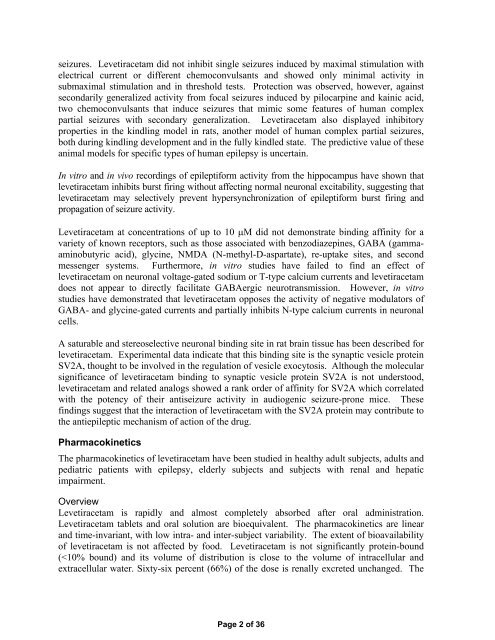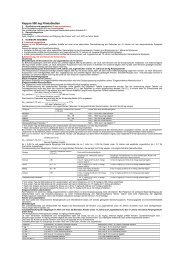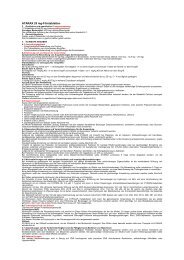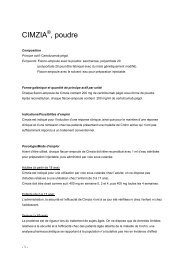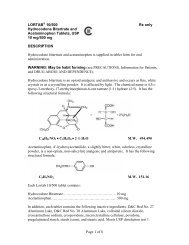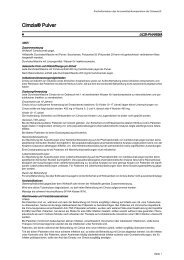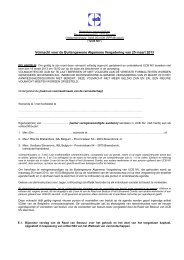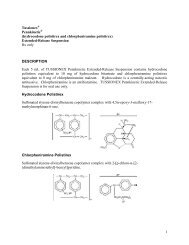KEPPRA (levetiracetam) Rx only 250 mg, 500 mg, 750 mg ... - UCB
KEPPRA (levetiracetam) Rx only 250 mg, 500 mg, 750 mg ... - UCB
KEPPRA (levetiracetam) Rx only 250 mg, 500 mg, 750 mg ... - UCB
You also want an ePaper? Increase the reach of your titles
YUMPU automatically turns print PDFs into web optimized ePapers that Google loves.
seizures. Levetiracetam did not inhibit single seizures induced by maximal stimulation with<br />
electrical current or different chemoconvulsants and showed <strong>only</strong> minimal activity in<br />
submaximal stimulation and in threshold tests. Protection was observed, however, against<br />
secondarily generalized activity from focal seizures induced by pilocarpine and kainic acid,<br />
two chemoconvulsants that induce seizures that mimic some features of human complex<br />
partial seizures with secondary generalization. Levetiracetam also displayed inhibitory<br />
properties in the kindling model in rats, another model of human complex partial seizures,<br />
both during kindling development and in the fully kindled state. The predictive value of these<br />
animal models for specific types of human epilepsy is uncertain.<br />
In vitro and in vivo recordings of epileptiform activity from the hippocampus have shown that<br />
<strong>levetiracetam</strong> inhibits burst firing without affecting normal neuronal excitability, suggesting that<br />
<strong>levetiracetam</strong> may selectively prevent hypersynchronization of epileptiform burst firing and<br />
propagation of seizure activity.<br />
Levetiracetam at concentrations of up to 10 μM did not demonstrate binding affinity for a<br />
variety of known receptors, such as those associated with benzodiazepines, GABA (gammaaminobutyric<br />
acid), glycine, NMDA (N-methyl-D-aspartate), re-uptake sites, and second<br />
messenger systems. Furthermore, in vitro studies have failed to find an effect of<br />
<strong>levetiracetam</strong> on neuronal voltage-gated sodium or T-type calcium currents and <strong>levetiracetam</strong><br />
does not appear to directly facilitate GABAergic neurotransmission. However, in vitro<br />
studies have demonstrated that <strong>levetiracetam</strong> opposes the activity of negative modulators of<br />
GABA- and glycine-gated currents and partially inhibits N-type calcium currents in neuronal<br />
cells.<br />
A saturable and stereoselective neuronal binding site in rat brain tissue has been described for<br />
<strong>levetiracetam</strong>. Experimental data indicate that this binding site is the synaptic vesicle protein<br />
SV2A, thought to be involved in the regulation of vesicle exocytosis. Although the molecular<br />
significance of <strong>levetiracetam</strong> binding to synaptic vesicle protein SV2A is not understood,<br />
<strong>levetiracetam</strong> and related analogs showed a rank order of affinity for SV2A which correlated<br />
with the potency of their antiseizure activity in audiogenic seizure-prone mice. These<br />
findings suggest that the interaction of <strong>levetiracetam</strong> with the SV2A protein may contribute to<br />
the antiepileptic mechanism of action of the drug.<br />
Pharmacokinetics<br />
The pharmacokinetics of <strong>levetiracetam</strong> have been studied in healthy adult subjects, adults and<br />
pediatric patients with epilepsy, elderly subjects and subjects with renal and hepatic<br />
impairment.<br />
Overview<br />
Levetiracetam is rapidly and almost completely absorbed after oral administration.<br />
Levetiracetam tablets and oral solution are bioequivalent. The pharmacokinetics are linear<br />
and time-invariant, with low intra- and inter-subject variability. The extent of bioavailability<br />
of <strong>levetiracetam</strong> is not affected by food. Levetiracetam is not significantly protein-bound<br />
(


